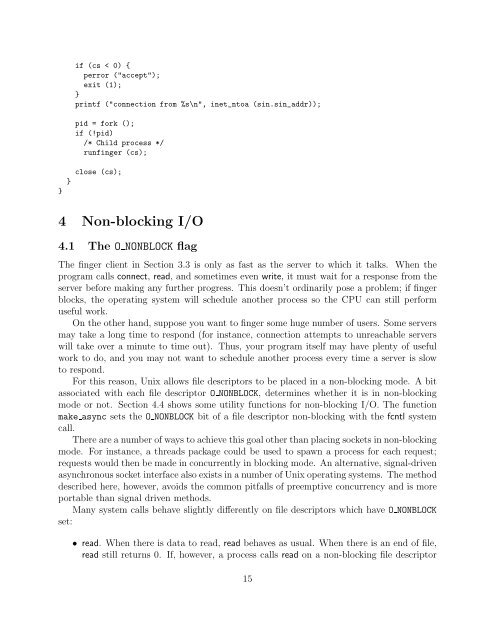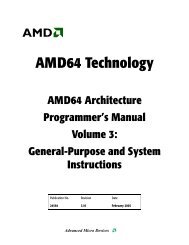Using TCP Through Sockets
Using TCP Through Sockets
Using TCP Through Sockets
You also want an ePaper? Increase the reach of your titles
YUMPU automatically turns print PDFs into web optimized ePapers that Google loves.
}<br />
}<br />
if (cs < 0) {<br />
perror ("accept");<br />
exit (1);<br />
}<br />
printf ("connection from %s\n", inet_ntoa (sin.sin_addr));<br />
pid = fork ();<br />
if (!pid)<br />
/* Child process */<br />
runfinger (cs);<br />
close (cs);<br />
4 Non-blocking I/O<br />
4.1 The O NONBLOCK flag<br />
The finger client in Section 3.3 is only as fast as the server to which it talks. When the<br />
program calls connect, read, and sometimes even write, it must wait for a response from the<br />
server before making any further progress. This doesn’t ordinarily pose a problem; if finger<br />
blocks, the operating system will schedule another process so the CPU can still perform<br />
useful work.<br />
On the other hand, suppose you want to finger some huge number of users. Some servers<br />
may take a long time to respond (for instance, connection attempts to unreachable servers<br />
will take over a minute to time out). Thus, your program itself may have plenty of useful<br />
work to do, and you may not want to schedule another process every time a server is slow<br />
to respond.<br />
For this reason, Unix allows file descriptors to be placed in a non-blocking mode. A bit<br />
associated with each file descriptor O NONBLOCK, determines whether it is in non-blocking<br />
mode or not. Section 4.4 shows some utility functions for non-blocking I/O. The function<br />
make async sets the O NONBLOCK bit of a file descriptor non-blocking with the fcntl system<br />
call.<br />
There are a number of ways to achieve this goal other than placing sockets in non-blocking<br />
mode. For instance, a threads package could be used to spawn a process for each request;<br />
requests would then be made in concurrently in blocking mode. An alternative, signal-driven<br />
asynchronous socket interface also exists in a number of Unix operating systems. The method<br />
described here, however, avoids the common pitfalls of preemptive concurrency and is more<br />
portable than signal driven methods.<br />
Many system calls behave slightly differently on file descriptors which have O NONBLOCK<br />
set:<br />
• read. When there is data to read, read behaves as usual. When there is an end of file,<br />
read still returns 0. If, however, a process calls read on a non-blocking file descriptor<br />
15
















